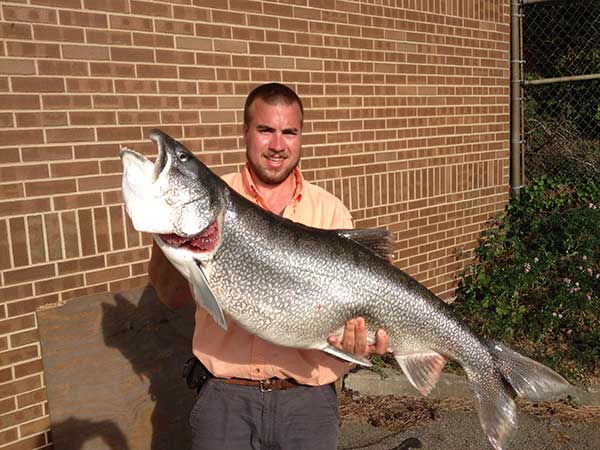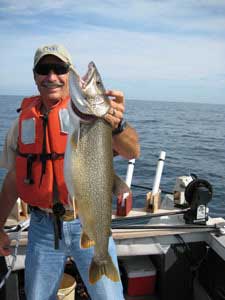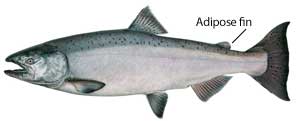- Details
One bite, one fish is all it takes to be a winner in the free Skamania Mania contest set for June 25-26 in Michigan City.
The 26th annual big steelhead contest starts at 12:01 a.m. on June 25 (Saturday) and concludes at 3 p.m. on June 26 (Sunday). No preregistration is required - just go fish.
Anglers catching the 12 largest steelhead over the two days win Cabelas gift cards starting with $200 for first place and going to $25 for 12th. The 13th biggest steelie wins a $200 rod and reel combo.
Weigh in times are 11 a.m. to 3 p.m. each day at the Northwest Indiana Steelheaders tent near the Coast Guard station on the Michigan City harbor. All of Lake Michigan and its tributaries may be fished. Complete rules are at www.nwisteelheaders.org.
- Details
(Provided by Indiana DNR)
 Indiana Lake Trout Record Shattered
Indiana Lake Trout Record Shattered
Indiana's youngest charter boat captain shattered the state lake trout record by "accidentally" catching a fish last weekend that was older than he is.
Tyler Kreighbaum, 25, owner of Tightline Fishing Charters in Michigan City, caught the fish in Lake Michigan on June 11. It measured 44 inches long and weighed 37.55 pounds, beating the previous state record by about 8 pounds. The former record was 29-4 set in 1993.
"I caught it by accident," Kreighbaum said. "I thought I was hooked on bottom. I was trying to break the line off."
Kreighbaum, his wife and first mate Britney, and five clients were trolling with downriggers near the Michigan state line. Kreighbaum said the trout came up easily, which was another reason he thought he had hooked debris, and not a fish.
Even after landing the fish, Kreighbaum didn't immediately recognize its significance.
- Details
(Provided by Michigan DNR)
 Expect good lake trout fishing on the big lakes.Each year the Michigan DNR assesses lake trout populations in lakes Superior, Michigan and Huron, using a fleet of specially designed Great Lakes research vessels to determine trends in their populations and their status toward being self-sustaining. The results of the 2015 surveys and outlook for 2016 for each lake are as follows:
Expect good lake trout fishing on the big lakes.Each year the Michigan DNR assesses lake trout populations in lakes Superior, Michigan and Huron, using a fleet of specially designed Great Lakes research vessels to determine trends in their populations and their status toward being self-sustaining. The results of the 2015 surveys and outlook for 2016 for each lake are as follows:
Lake Superior
Lake trout abundance is monitored through surveys conducted annually in the spring for adult abundance and summer for juveniles. Lake trout abundance in Michigan waters of Lake Superior has remained stable over the past 10 years following a decline from peak abundances in the later part of the 1990s.
Juvenile lake trout numbers in the survey declined following the same trend seen since 2011. Sea lamprey-induced mortality, the major source of lake trout deaths in Lake Superior, continued to remain above the target level as it has since 1992. The 2016 outlook is to expect similar populations of adult and juvenile lake trout in Lake Superior as seen in 2015.
- Details
(Provided by Indiana DNR)
The Indiana DNR will be stocking additional trout into five northern Indiana streams in the coming days.
Included in the stockings are the Pigeon River in Steuben and LaGrange Counties, Turkey Creek in LaGrange County, Little Elkhart River in Elkhart County, Little Kankakee River in LaPorte County and Potato Creek in St. Joseph County.
The Pigeon River, Turkey Creek and the Little Elkhart River will be stocked for the weekend of May 14-15 and May 28-29, Memorial Day weekend. The Little Kankakee River and Potato Creek will only be stocked for the Memorial Day weekend.
- Details
Michigan DNR Report
 All Chinook salmon stocked in Lake Superior since 2012 have received adipose fin clips.The Michigan DNR says that Michigan's Lake Superior Chinook salmon fishery is being fueled almost entirely from natural reproduction. Data show more than 99 percent of the Lake Superior Chinook salmon caught by anglers are wild.
All Chinook salmon stocked in Lake Superior since 2012 have received adipose fin clips.The Michigan DNR says that Michigan's Lake Superior Chinook salmon fishery is being fueled almost entirely from natural reproduction. Data show more than 99 percent of the Lake Superior Chinook salmon caught by anglers are wild.
All 1.5 million Chinook salmon stocked in Lake Superior since 2012 have received adipose fin clips via the U.S. Fish and Wildlife Services mass marking program, making it easy to distinguish which fish are either wild or of hatchery origin. The percentage of fish that are wild is derived from the ratio of unclipped versus clipped Chinook salmon examined by DNR creel clerks. These percentages have been very high for three years running, lending increased confidence to the finding.





